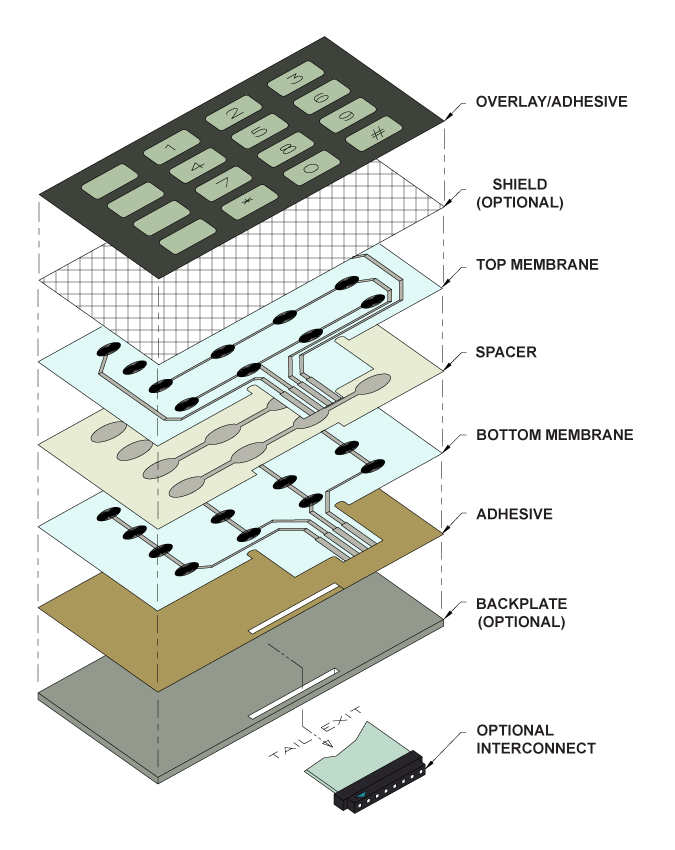How Membrane Layer Switches Add To the Longevity of Electronic Control Panels
Membrane layer buttons play a critical duty in improving the longevity of electronic control panels, primarily via their multi-layered building and construction which gives effective defense versus environmental variables such as moisture and dirt. This style not only minimizes the danger of circuit damages and deterioration but also promotes convenience of maintenance because of its seamless surface. Additionally, the absence of moving parts significantly reduces the possibility of mechanical failings, making membrane layer switches over ideal for requiring applications. The ramifications of these functions prolong past mere security, elevating concerns regarding their more comprehensive impact on functionality and individual experience.
Interpretation of Membrane Switches

Membrane buttons are designed to be slim and light-weight, making them appropriate for applications where area is restricted. They can be manufactured in various shapes, sizes, and shades, offering adaptability in layout that fulfills aesthetic and functional requirements. Additionally, membrane layer switches can incorporate different modern technologies, such as tactile responses and LED signs, improving customer experience.
Due to their building, membrane layer buttons are usually immune to dust, moisture, and basic wear, adding to their resilience popular atmospheres. Their smooth design not just assists in easy cleansing yet additionally minimizes the danger of mechanical failing, making them a preferred choice for makers seeking trusted interface in their electronic control panels.
Protection Against Ecological Factors
The layout of membrane switches inherently supplies a degree of defense versus various ecological factors, which is vital for preserving functionality in difficult conditions - Membrane Switch. These buttons are commonly created with layers of flexible products that secure inner components from wetness, dust, and pollutants. By enveloping the wiring, membrane layer switches over reduce the threat of brief circuits and corrosion, which can substantially impair performance
In addition, the usage of durable adhesives and sealants throughout production boosts their resistance to environmental obstacles. Membrane layer switches can withstand direct exposure to chemicals and solvents, making them suitable for industries such as food processing and medical care, where health and tidiness are paramount. Their seamless surface style also avoids the accumulation of dust and bacteria, assisting in easier cleaning and maintenance.
Temperature fluctuations are one more environmental problem, and membrane buttons are engineered to function effectively across a large range of temperatures (Membrane Switch). This flexibility makes certain that control panels remain functional in various settings, from commercial atmospheres to customer electronics
Effect On Customer Interaction
Customer communication with digital control panels is dramatically influenced by the style and functionality of membrane switches. These switches give a tactile user interface that enhances the general customer experience, allowing for user-friendly navigating and control. Their responsive nature makes sure that users get instant responses upon activation, which is important for jobs calling for accuracy and efficiency.
Moreover, the smooth surface of membrane layer switches helps with very easy cleaning and upkeep, promoting user self-confidence in the integrity of the interface. This cleanliness is especially vital in environments where health is paramount, such as medical or food processing setups. Additionally, the portable and light-weight design of membrane layer switches over adds to the visual allure of control board, encouraging individual involvement through a modern-day and smooth appearance.
Moreover, the assimilation of visual components, such as published icons and backlighting, helps users swiftly recognize functions, reducing the learning curve related to new tools. Because of this, click here to read individuals can operate tools more effectively, leading to enhanced performance and satisfaction. In summary, membrane layer switches play an essential duty in a fantastic read boosting individual interaction by incorporating capability, looks, and convenience of use, inevitably causing enhanced operational performance.
Design Flexibility and Modification
Style versatility and personalization are important elements of membrane buttons, allowing makers to tailor electronic control panels to certain applications and individual requirements. This adaptability permits the assimilation of various layout aspects, such as shades, graphics, and appearances, which can improve the aesthetic appeal and customer involvement of the control panel.
Membrane layer buttons can be customized in shapes and size, accommodating a broad variety of devices and applications, from industrial equipment to consumer electronic devices. This adaptability ensures that producers can create intuitive interfaces that line up with individual expectations and functional requirements. In addition, the capacity to include one-of-a-kind attributes such as backlighting or tactile feedback better boosts functionality, permitting a more interactive experience.
Moreover, the manufacturing procedure for membrane layer switches supports the quick prototyping of layouts, allowing producers to iterate and improve their principles promptly. This capacity not just find out speeds up the growth timeline yet additionally guarantees that the end product fulfills specific useful and aesthetic standards.

Cost-Effectiveness and Durability
Cost-effectiveness and longevity are considerable benefits of membrane switches, making them an eye-catching option for makers and end-users alike. These buttons are commonly much less expensive to generate than conventional mechanical buttons, largely as a result of their streamlined production procedures and the lowered number of components required. This price benefit expands not only to initial manufacturing but likewise to long-lasting operational expenses, as membrane buttons commonly require much less upkeep and have a reduced failure rate.
Furthermore, the longevity of membrane layer switches adds to their general worth. Built from long lasting materials, they are resistant to ecological factors such as wetness, dust, and chemicals, which can lead to premature wear in various other button types. The lack of relocating components minimizes mechanical failure, permitting membrane switches over to preserve functionality over prolonged periods.
This durability is especially beneficial in applications calling for consistent performance under requiring conditions, such as clinical devices and industrial equipment. Inevitably, the mix of cost-effectiveness and long life makes membrane changes an economically sensible option for producers, supplying reputable remedies that endure the examination of time while optimizing monetary factors to consider.
Final Thought
In verdict, membrane switches substantially enhance the toughness of digital control panels through their robust building and protective features - Membrane Switch. On the whole, membrane changes represent a reputable and affordable choice for boosting the durability and functionality of electronic control systems.